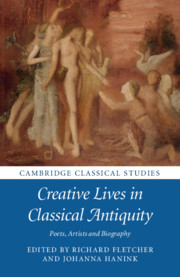Book contents
- Frontmatter
- Contents
- List of contributors
- List of illustrations
- Part I Opening remarks
- Part II Reviving dead poets
- Part III Lives in unexpected places
- Part IV Laughing matters and Lives of the mind
- Part V Portraits of the artist
- 11 ‘It is Orpheus when there is singing’: the mythical fabric of musical lives
- 12 The artist as anecdote: creating creators in ancient texts and modern art history
- 13 Freud and the biography of antiquity
- Envoi
- Works cited
- Index
11 - ‘It is Orpheus when there is singing’: the mythical fabric of musical lives
from Part V - Portraits of the artist
Published online by Cambridge University Press: 01 December 2016
- Frontmatter
- Contents
- List of contributors
- List of illustrations
- Part I Opening remarks
- Part II Reviving dead poets
- Part III Lives in unexpected places
- Part IV Laughing matters and Lives of the mind
- Part V Portraits of the artist
- 11 ‘It is Orpheus when there is singing’: the mythical fabric of musical lives
- 12 The artist as anecdote: creating creators in ancient texts and modern art history
- 13 Freud and the biography of antiquity
- Envoi
- Works cited
- Index
Summary
He was given his lyre when he was still a child, barely taller than the frame. Calliope, steadying him, showed him how to chant like her as he played. All his poet's art, and much of his mystic wisdom, was apparently learned from her.
This fragment makes for an intriguing addition to our collection of ancient lives. The vignette of the child prodigy, learning his art from a goddess in a form of epiphany, satisfies our craving for an account of the early discovery of talent and for the divine sanctioning of genius, in the type of tale developed, for example, in Vasari's Lives of the Artists and explored by Kris and Kurz. Yet the quotation does not come from any ancient or Renaissance account: the musician of the epigraph is Orpheus, and the work from which it is taken is Ann Wroe's Orpheus: The Song of Life (2011). A suggestive addition to the thousands of artistic objects inspired by the figure of Orpheus, Ann Wroe's book is a modern work of creative supplementation that takes the form of a biography of the musical hero, embedded in imagined moments of the life of Rainer Maria Rilke, as he was trying to finish a ‘great symphony of poetry, his Duino Elegies’. Soon the figure of Rilke disappears, and seven chapters mapped onto the seven strings of Orpheus’ kithara describe important moments of the musician's life: his origins and the early signs of his musical nature, his training, his Argonautic adventures, priestly activities, marriage, travel to the Underworld and death. We hear about his sandals and Thracian coat, his priestly robes and proud demeanour, the golden strap of his lyre, the tone of his voice – high, sweet and clear – and the colour of his eyes – slate grey (or perhaps, entranced by the book's lyricism, I imagined that last detail?). Like the operas, novels, sculptures, poems and paintings celebrating Orpheus, the book is a meditation on the nature, power and meaning of art and on the processes of creation and performance. More specifically, the subtitle of Wroe's book (The Song of Life) engages directly with the project of the current volume.
- Type
- Chapter
- Information
- Creative Lives in Classical AntiquityPoets, Artists and Biography, pp. 243 - 273Publisher: Cambridge University PressPrint publication year: 2016
- 1
- Cited by

